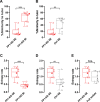Autism-linked gene FoxP1 selectively regulates the cultural transmission of learned vocalizations
- PMID: 33536209
- PMCID: PMC7857683
- DOI: 10.1126/sciadv.abd2827
Autism-linked gene FoxP1 selectively regulates the cultural transmission of learned vocalizations
Abstract
Autism spectrum disorders (ASDs) are characterized by impaired learning of social skills and language. Memories of how parents and other social models behave are used to guide behavioral learning. How ASD-linked genes affect the intertwined aspects of observational learning and behavioral imitation is not known. Here, we examine how disrupted expression of the ASD gene FOXP1, which causes severe impairments in speech and language learning, affects the cultural transmission of birdsong between adult and juvenile zebra finches. FoxP1 is widely expressed in striatal-projecting forebrain mirror neurons. Knockdown of FoxP1 in this circuit prevents juvenile birds from forming memories of an adult song model but does not interrupt learning how to vocally imitate a previously memorized song. This selective learning deficit is associated with potent disruptions to experience-dependent structural and synaptic plasticity in mirror neurons. Thus, FoxP1 regulates the ability to form memories essential to the cultural transmission of behavior.
Copyright © 2021 The Authors, some rights reserved; exclusive licensee American Association for the Advancement of Science. No claim to original U.S. Government Works. Distributed under a Creative Commons Attribution NonCommercial License 4.0 (CC BY-NC).
Figures








Similar articles
-
Differential Song Deficits after Lentivirus-Mediated Knockdown of FoxP1, FoxP2, or FoxP4 in Area X of Juvenile Zebra Finches.J Neurosci. 2019 Dec 4;39(49):9782-9796. doi: 10.1523/JNEUROSCI.1250-19.2019. Epub 2019 Oct 22. J Neurosci. 2019. PMID: 31641053 Free PMC article.
-
Effects of Cortical FoxP1 Knockdowns on Learned Song Preference in Female Zebra Finches.eNeuro. 2023 Mar 29;10(3):ENEURO.0328-22.2023. doi: 10.1523/ENEURO.0328-22.2023. Print 2023 Mar. eNeuro. 2023. PMID: 36931727 Free PMC article.
-
Expression analysis of the speech-related genes FoxP1 and FoxP2 and their relation to singing behavior in two songbird species.J Exp Biol. 2013 Oct 1;216(Pt 19):3682-92. doi: 10.1242/jeb.085886. J Exp Biol. 2013. PMID: 24006346 Free PMC article.
-
Memory circuits for vocal imitation.Curr Opin Neurobiol. 2020 Feb;60:37-46. doi: 10.1016/j.conb.2019.11.002. Epub 2019 Dec 4. Curr Opin Neurobiol. 2020. PMID: 31810009 Free PMC article. Review.
-
The sensitive period for auditory-vocal learning in the zebra finch: Consequences of limited-model availability and multiple-tutor paradigms on song imitation.Behav Processes. 2019 Jun;163:5-12. doi: 10.1016/j.beproc.2017.07.007. Epub 2017 Jul 23. Behav Processes. 2019. PMID: 28743517 Free PMC article. Review.
Cited by
-
Induction of an immortalized songbird cell line allows for gene characterization and knockout by CRISPR-Cas9.Sci Rep. 2022 Mar 14;12(1):4369. doi: 10.1038/s41598-022-07434-7. Sci Rep. 2022. PMID: 35288582 Free PMC article.
-
Investigating the Neurobiology of Abnormal Social Behaviors.Front Neural Circuits. 2021 Nov 30;15:769314. doi: 10.3389/fncir.2021.769314. eCollection 2021. Front Neural Circuits. 2021. PMID: 34916912 Free PMC article. No abstract available.
-
Avian models for brain mechanisms underlying altered social behavior in autism.Front Physiol. 2022 Oct 28;13:1032046. doi: 10.3389/fphys.2022.1032046. eCollection 2022. Front Physiol. 2022. PMID: 36388132 Free PMC article. Review.
-
Symptomatic, Genetic, and Mechanistic Overlaps between Autism and Alzheimer's Disease.Biomolecules. 2021 Nov 4;11(11):1635. doi: 10.3390/biom11111635. Biomolecules. 2021. PMID: 34827633 Free PMC article. Review.
-
Slivers of the spectrum.Nat Biotechnol. 2021 May;39(5):540-545. doi: 10.1038/s41587-021-00913-8. Nat Biotechnol. 2021. PMID: 33888895 Free PMC article.
References
-
- Bolhuis J. J., Okanoya K., Scharff C., Twitter evolution: Converging mechanisms in birdsong and human speech. Nat. Rev. Neurosci. 11, 747–759 (2010). - PubMed
-
- Doupe A. J., Kuhl P. K., Birdsong and human speech: Common themes and mechanisms. Annu. Rev. Neurosci. 22, 567–631 (1999). - PubMed
-
- H. Tager-Flusberg, R. Paul, C. E. Lord, Language and communication in autism, in Handbook of Autism and Pervasive Developmental Disorders, and Behavior, R. P. F. Volkmar, A. Klin, D. J. Cohen, Eds. (Wiley, ed. 3, 2005), vol. 1, pp. 335–364.
Publication types
Grants and funding
LinkOut - more resources
Full Text Sources
Other Literature Sources

